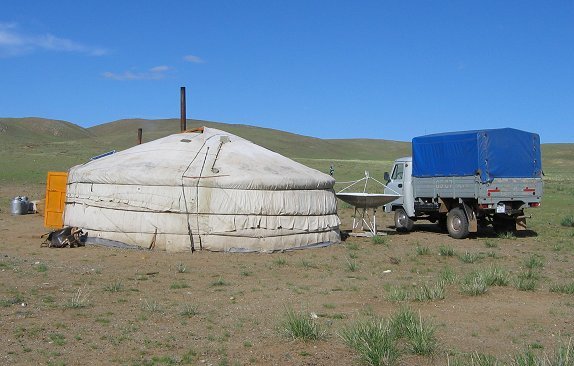| This Web book is based on public domain material provided by the US government and is available in several versions. See the editorial for more information. |

|

Home  The Society and Its Environment The Society and Its Environment  Society Society  Collectivized Farming and Herding Collectivized Farming and Herding  Modernized Nomads Modernized Nomads |
|||
| See also: Pastoral Nomadism, Increasing Social Differentiation, Collectivized Farming and Herding | |||






|
|||
Modernized Nomads
In contrast to the period before the collectivization of herding, which was carried out in the late 1950s, the work of individual herders in the late 1980s was more closely supervised by administrative authorities. Herders were responsible for a herd of collective animals that usually included some of their privately held stock as well, thus providing an incentive for careful management. Herders with a record of losing too many animals or failing to meet monthly or annual quotas were deprived of custody of the collective animals and were reassigned to other tasks. The moves of the herds and the herding camps were plotted on a map in the cooperative's headquarters, and officials of the cooperative - riding on motorcycles or jeeps, and on a more limited basis, airplanes - scouted for good pasture and then told the herding camps where to move next. Moves from one campsite to the next usually were made, using the cooperative's jeeps or trucks, and sometimes crossing the roadless steppes at night with uncanny accuracy. The cooperatives attempted, with mixed success, to grow hay and other fodder, which was stored at the winter campsites, some of which had barns and sheds to shelter animals. Herding camps were assigned to winter campsites, which often were provided with stocks of coal and sometimes with portable electric generators to provide power for lights and even television sets. Herders on the range used transistor radios to listen to weather reports and storm warnings.
The somon center became a miniature urban outpost, providing a meeting hall for regular assemblies of the cooperative, political rallies, plays, concerts, and films; for the administrative offices of the somon and the cooperative; for a clinic, or small hospital, and a veterinary clinic; for the motor pool and vehicle repair station; for shops, run by the state trading organization; for storage and processing facilities for food and wool; for a sports ground, and for a school with boarding facilities. The center kept in touch with the herding camps through radio telephones and motorcycle couriers, who, bearing messages, mail, and newspapers, usually visited the camps every three to five days. Like urban residents or state-sector employees, herders from cooperatives were eligible for annual vacations, often spent at the holiday camps or spas operated by aymag governments. The government and the party took care to recognize the value of the herders' work and devoted resources to improving their lives without demanding that they settle down in permanent dwellings. In this regard, Mongolian pastoralists were more fortunate than their counterparts in many countries in Asia and Africa. There, urban-based governments attempted to force nomads to settle down and to abandon their migrations for what was thought of as a more modern and civilized way of life, but that usually proved detrimental to the livelihood of the nomads and to the national economy. The pastoral background of Mongolia's leaders and their understanding of the realities of the nomadic way of life produced policies designed to modernize, but not to destroy, an ancient and productive ecological system.
|
|||
Home  The Society and Its Environment The Society and Its Environment  Society Society  Collectivized Farming and Herding Collectivized Farming and Herding  Modernized Nomads Modernized Nomads |
|||
Last Update: 2010-12-07


